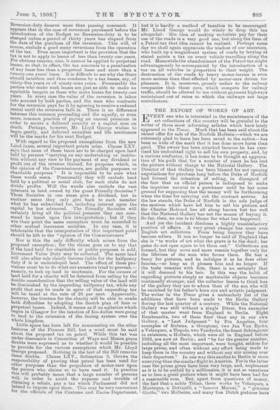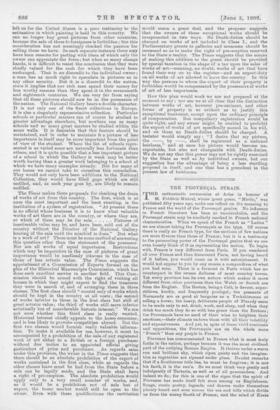THE EXPORT OF WORKS OF ART. E VERY one who is
interested in the maintenance of the art collections of this country will be grateful to the writer of three most informing articles which have lately appeared in the Times. Much that has been said about the recent offer for sale of the Norfolk Holbein—which we are extremely glad to learn has been saved to the nation—has been so wide of the mark that it has done more harm than good. The owner has been attacked because he has exer- cised his undoubted right to sell his own property, and, by a curious confusion, it has come to be thought an aggrava- tion of his guilt that for a number of years he has lent the picture without charge to the National Gallery. The Director of that Gallery has been blamed for not opening negotiations for purchase long before the Duke of Norfolk had formed the intention of selling, in disregard of the fact that an official person is indisposed to make the inquiries natural in a purchaser until he has some ground for supposing that the money will be forthcoming when the time for carrying out the contract arrives. As the law stands, the Duke of Norfolk is the sole judge of the motives which have led him to sell his picture, and. Sir Charles Holroyd has all along known but too well that the National Gallery has not the means of buying it. So far, then, no one is to blame for what has happened.
And yet the incident discloses a highly unsatisfactory, position of affairs. A very great change has come over English art collectors. From being buyers they have become sellers. It can no longer be said of England that she is "to works of art what the grave is to the dead ; her gates do not open again to let them out." Collections are formed, but they more and more remain together only for the lifetime of the man who forms them. He has a fancy for pictures, and he indulges it as he does other, faucies,—so long as it pleases him and no longer. If, the taste remains with him, there is no certainty that it will descend to his heir. In this way the habit of regarding pictures simply as marketable objects becomes continually stronger, and the collector learns to think less of the gallery they are to adorn than of the son who will be enriched by his father's keen eye and artistic judgment. The writer in the Times gives a melancholy list of the additions that have been made to the Berlin Gallery: during the last quarter of a century. While the National Gallery was still without a single Darer, five examples of that master went from England to Berlin. Eight Rembrandts, two of them finer than any in our own Gallery, a "Last Judgment" by I'm Angelico, four examples of Rubens, a Giorgione, two Jan Van Eyck's, a Velazquez, a Tiepolo, two Vaudycks, the finest Schongrtuer in existence, a Holbein, which were all in England before 1882, are now at Berlin ; and "by far the greater number, including all the most important, were bought, seldom for large prices, and often without any effort being made to keep them in the country and without any stir arising over their departure." In one way this exodus to Berlin is more annoying than the similar flight to America. For in the latter case the prices given have been very large, and, unpleasant: as it is to be outbid by a millionaire, it is not so vexatious , as to lose a great picture when it might have been had for' a reasonable sum. But, apart from questions of money,. the fact that a noble Titian, three works by Velazquez, a Mantegna, a BotticAli, a "famous Moroni," a "genuine Giotto," two Holbeins, and many fine Dutch pictures have left us for the United States is a poor testimony to the estimation in which painting is held in this country. We can no longer buy great pictures from other countries, because the sale of them to foreigners is forbidden ; but this consideration has not seemingly checked the passion for selling those we have. In each separate instance there may have been reasons for parting with them of which only the owner can appreciate the force ; but when so many change hands, it is difficult to resist the conclusion that they were chiefly valued for the cash for which they have been exchanged. That is no discredit to the individual owner ; a man has as much right to speculate in pictures as in any other security. But it is a discredit to the nation, since it implies that our rich men spend their money for loss worthy reasons than they spent it in the seventeenth and eighteenth centuries. We are very far from saying that all these pictures should now be in the possession of the nation. The National Gallery bears a double character. It is not only one of the finest collections in Europe, it is also a singularly representative collection. Particular schools or particular masters can of course be studied to greater advantage elsewhere, but nowhere can so many schools and so many great masters be studied within the same walls. It is desirable that this feature should be maintained, and in order to maintain it a picture of less importance in itself may be more important from the point of view of the student. Where the list of schools repre- sented is so varied some are naturally less fortunate than others, and it is quite possible that a less important picture of a school in which the Gallery is weak may be better worth having than a greater work belonging to a school of which we have many examples already. But for many of our losses we cannot take to ourselves this consolation. They would not only have been additions to the National Collection, they would, have filled gaps which are still unfilled, and, as each year goes by, are likely to remain. unfilled.
The Times makes three proposals for checking the drain of works of art from this country. The first, which is at once the most important and the least exacting, is the institution of a system of registration. "At present there is no official whose business it is to know what valuable works of art there are in the country, or where they are, or which of them may be for sale Pictures of inestimable value may be, and have been, sold out of the country without the Director of the National Gallery hearing of the sale until the mischief is done." But what is a work of art? There must be some method of answering this question other than the statement of the possessor.
Nor are all works of equal importance. Restrictions which may be imperative in the ease of pictures of great importance would be needlessly irksome in the case of those of less artistic value. The Times suggests the appointment of a Commission of Experts formed on the plan of the Historical Manuscripts Commission, which has done such excellent service in another field. This Com- mission should be armed with the right of visiting all houses in which they might expect to find the treasures they were in search of, and of arranging them in three classes. The first class should "consist only of works which should be kept in the country at all costs ; the second of works inferior to those in the first class but still of great artistic value; the third of works still more inferior artistically but of considerable historic interest." We are not sure whether this third class is really wanted. Historical interest chiefly appeals to the home consumer, and is less likely to provoke competition abroad. But the first two classes would furnish really valuable informa- tion. To make it available for use, however, it must be. accompanied by a prohibition of the sale of any registered work of art either to a British or a foreign purchaser without due notice to an appointed official giving particulars of price and purchaser. As regards sales under this provision, the writer in the Times suggests that there should be an absolute prohibition of the export of works contained in the first class, while as regards the other classes leave must be had from the State before a sale can be legally made, and the State shall have a right of pre-emption. The absolute prohibition would npply only to a very small number of works, and, as it would be a prohibition not of sale but of export, the home market would still be open to the owner. Even with these qualifications the restriction would mean a great deal, and the proposer suggests that the owners of these exceptional works should be compensated in two ways. No Death-duties should be charged on works of art included in Class I., and the Parliamentary grants to galleries and museums should be increased so as to make the right of pre-emption reserved to the State a reality. The Times. suggests that the means of making this addition to the grant should be provided by special 'taxation in the shape of a tax upon the sales of works of art—meaning, no doubt, works of art that have found their way on to the register—and an export-duty on all works of art allowed to leave the country. In this way the persons to whom the export of their property is forbidden would be compensated by the possessors of works of art of loss importance.
How this plan would work we are not prepared at the moment to say ; nor are we at all clear that the distinction between works of art, however pre-emineut, and other forms of property is so evident as to justify this exceptional treatment, except upon the ordinary principle of compensation. But compulsory registration would be quite right, and any owner might be enabled to prohibit the export of works of art specifically named in his will, and on these no Death-duties should be charged. A testator would simply say : "I desire that my picture, the —, by —, shall be registered as a national heirloom," and at once his picture would become tin, exportable, but also not chargeable with Death-duties. We do not say that this power may not be rightly exercised by the State as well as ,by individual owners, but our suggestion has the advantage of being a less startling proposal in itself, and one that has a precedent in tho present law of heirlooms.











































 Previous page
Previous page